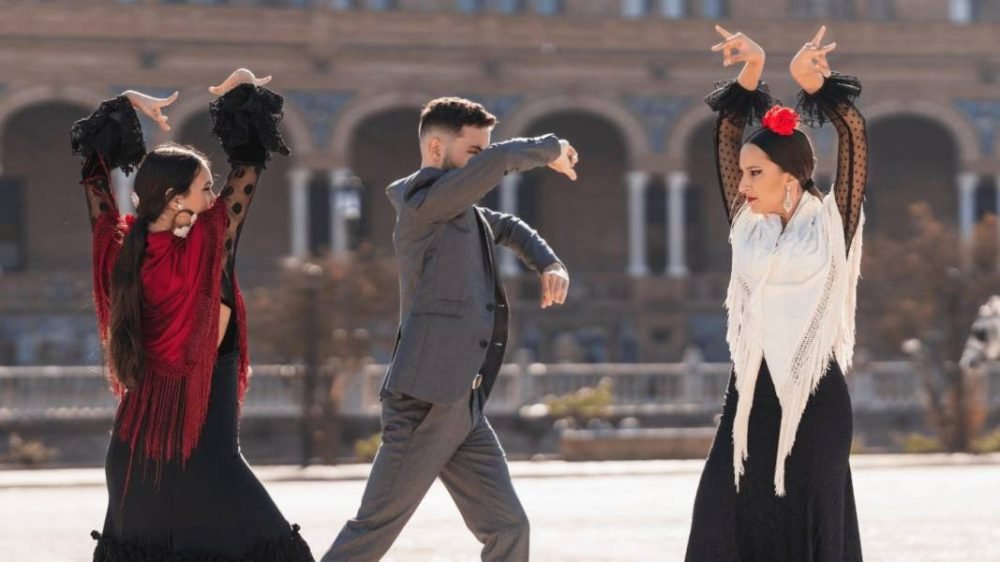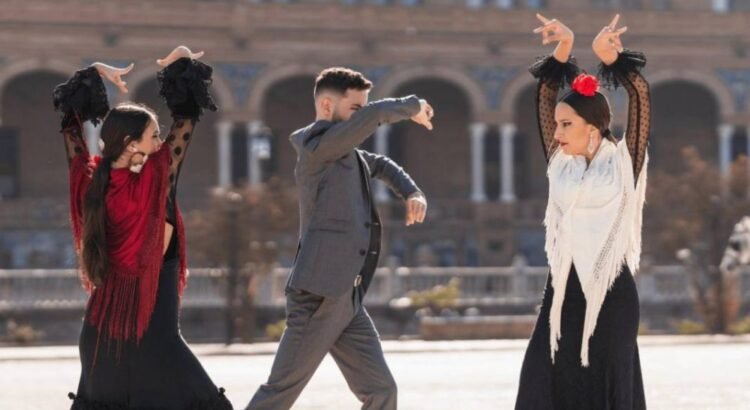
There are few experiences in the world that stir the soul quite like flamenco. More than a musical genre, flamenco is an emotional language—a deeply expressive art form that rises from the depths of sorrow, erupts with joy, and flows through the veins of Spanish culture. To travel through Spain with flamenco as your guide is to open your heart to passion, storytelling, and centuries of cultural fusion.
Whether you’re watching a dancer stomp out heartbreak on a wooden stage in Seville, listening to a raspy voice mourn lost love in Granada, or learning clapping rhythms in a sun-soaked courtyard in Córdoba, flamenco leads you into journeys that are as emotional as they are geographical. Let this guide take you through the heartlands of flamenco—Andalusia and beyond—as you follow its rhythms into unforgettable, passionate adventures.
A Living Tradition: The Soul Of Andalusia
Flamenco was born in Andalusia, the sun-drenched southern region of Spain where centuries of history, hardship, and cultural fusion created something truly unique. Rooted in the lives of the Romani (Gitanos), as well as Moorish, Jewish, and Andalusian folk traditions, flamenco emerged as a powerful expression of struggle, identity, and resilience.
Today, flamenco is alive in the streets and spirit of Andalusia. Its three essential elements—cante (singing), toque (guitar playing), and baile (dance)—are woven into daily life. Flamenco is not staged; it’s felt. It bursts forth from intimate gatherings, late-night bars, spontaneous street performances, and festivals where time seems to stand still.
Seville: The Heartbeat Of Flamenco
Your journey begins in Seville (Sevilla), widely regarded as the spiritual capital of flamenco. The city is a whirlwind of color, architecture, and motion. Cobbled streets wind through the old quarter of Santa Cruz, orange trees perfume the air, and horse-drawn carriages trot past palaces that gleam under the Andalusian sun.
But as day turns into night, the city transforms. Hidden behind wooden doors and tiled patios are the tablaos—intimate flamenco venues where magic happens. One such place is Casa de la Memoria, where the silence before a performance is electric. A guitarist begins with a solitary strum, a singer wails from the core of his being, and a dancer—feet sharp as castanets—conquers the stage with each stamp.
Seville also offers flamenco schools and museums, including the Museo del Baile Flamenco, founded by renowned dancer Cristina Hoyos. Here, you can delve into the history of the art form, try on traditional costumes, and even take a beginner’s class to feel the rhythm for yourself.
Granada: Where Flamenco Echoes Through Caves
Next, you venture to Granada, a city nestled beneath the snow-capped Sierra Nevada mountains. Granada is famous for the Alhambra, its Moorish palace, but for flamenco enthusiasts, its soul lies in the Sacromonte district. Here, the Romani community once carved homes into the hillside caves—and in these same caves, flamenco thrives.
Attending a zambra—a form of flamenco danced barefoot in the intimate, cave-like settings of Sacromonte—is like stepping into another world. The performance is raw and visceral, illuminated by candlelight and fueled by an ancient connection to the land. Flamenco here is not choreographed for perfection—it is spontaneous, imperfect, and real.
The Sacromonte Flamenco Museum offers deeper insight into the evolution of flamenco in Granada, and for a modern touch, venues like Le Chien Andalou blend tradition with contemporary flair.
Córdoba: The Rhythm Of Resistance And Reverence
In Córdoba, flamenco carries a tone of both defiance and devotion. Once a thriving hub of Islamic, Jewish, and Christian scholarship, the city’s Mezquita-Catedral stands as a symbol of this intertwined heritage. And just like the city itself, flamenco in Córdoba is layered—both sacred and rebellious.
Attend a performance at Tablao El Cardenal, housed within a historic 17th-century building, where the stone walls resonate with guitar strings and echo the percussive beat of heels on wood. The emotion here is overwhelming—there is often no need for translation. Flamenco speaks directly to your heart.
Wander the Judería (Jewish Quarter), take in the scent of jasmine, and listen for the distant strum of a Spanish guitar. You may even be lucky enough to catch an impromptu peña flamenca—a flamenco club where locals gather to play, sing, and dance late into the night.
Jerez De La Frontera: The Cradle Of Cante
If Seville is flamenco’s heart, Jerez de la Frontera is its voice. Revered as the birthplace of cante jondo—the “deep song” of flamenco—Jerez is a must-visit for purists. The music here is more solemn, more rooted in ancient lamentations, more soul-bearing.
Jerez is also the home of the Festival de Jerez, held each spring, drawing the world’s finest flamenco artists for two weeks of performance and celebration. During the festival, the city becomes a living stage. Plazas host late-night jams, classrooms burst with workshops, and flamenco is no longer an art form—it is a way of life.
Pair your experience with the local sherry wine and you’ll begin to understand the intoxicating blend of elegance and grit that defines this city’s unique relationship with flamenco.
Madrid: Flamenco’s Urban Stage
While flamenco is rooted in Andalusia, it has found a powerful stage in Madrid, Spain’s cosmopolitan capital. Here, flamenco takes on new forms—more polished, perhaps, but no less heartfelt. Madrid is home to some of Spain’s most legendary tablaos, such as Corral de la Morería and Casa Patas.
These venues host world-class performers, blending traditional artistry with contemporary innovation. You might witness a dancer dressed in modern attire but channeling the spirit of old-world duende—that untranslatable term for the soul or fire that animates true flamenco.
Madrid is also where flamenco enters academia. The Conservatorio Profesional de Danza and the Amor de Dios flamenco school attract students from all over the world who come not only to learn the steps but to embody the soul of flamenco.
Flamenco As A Personal Journey
To follow flamenco through Spain is to take a personal journey—not just across geography, but into the depths of human emotion. Flamenco teaches you to feel openly, to listen deeply, and to express through your body what words cannot contain.
Try joining a beginner’s workshop and you’ll quickly realize that flamenco isn’t about perfection—it’s about presence. It’s about letting your fingers pluck the strings of emotion, allowing your palms to mark the tempo of your heart, and letting your feet speak truths your mouth cannot utter.
Whether you’re dancing, clapping, or simply watching, flamenco reminds you that vulnerability is a strength, and that passion is a path—not a destination.
The Cultural Tapestry Behind The Rhythm
Flamenco’s strength lies not only in its emotional depth but in its cultural richness. Each note, step, and gesture carries the weight of history—of a people oppressed and marginalized, of religious tolerance and conflict, of empires risen and fallen.
As you immerse yourself in the flamenco world, you’ll hear stories of longing and exile, of love and betrayal, of festivity and grief. These stories are passed down through generations and encoded in the rhythms, just waiting to be uncovered.
And as you travel across cities, from ornate cathedrals to humble taverns, you begin to understand: flamenco is Spain’s soul singing aloud.
Tips For Travelers Seeking Flamenco
If flamenco is your calling card for travel, here are a few tips:
- Choose authenticity over commercial shows. Look for smaller tablaos and local peñas rather than tourist-heavy spectacles.
- Visit during festivals, such as the Festival de Jerez or La Bienal de Flamenco in Seville.
- Take a class, even if you’re a beginner. You’ll gain a deeper appreciation through experience.
- Ask locals. The best performances are often off the beaten path.
- Embrace late nights—the flamenco world often comes alive after midnight.
Final Thoughts: Let The Rhythm Carry You
In a world that often rushes forward, flamenco urges you to stop and feel. To close your eyes and listen. To connect—not just with a place, but with your own heart. In the hands of a guitarist, in the voice of a cantaor, in the fire of a dancer’s eyes—you find yourself reflected.
So let the rhythms of Spain’s flamenco lead you, not just through the country’s most storied cities, but into the realms of emotion, memory, and passion. Follow the echoes of a tradition that has endured for centuries, and let its songs become your own.
Because in Spain, when you travel with flamenco in your soul, every step becomes a dance, every city a stage, and every heartbeat a rhythm of your own passionate journey.




